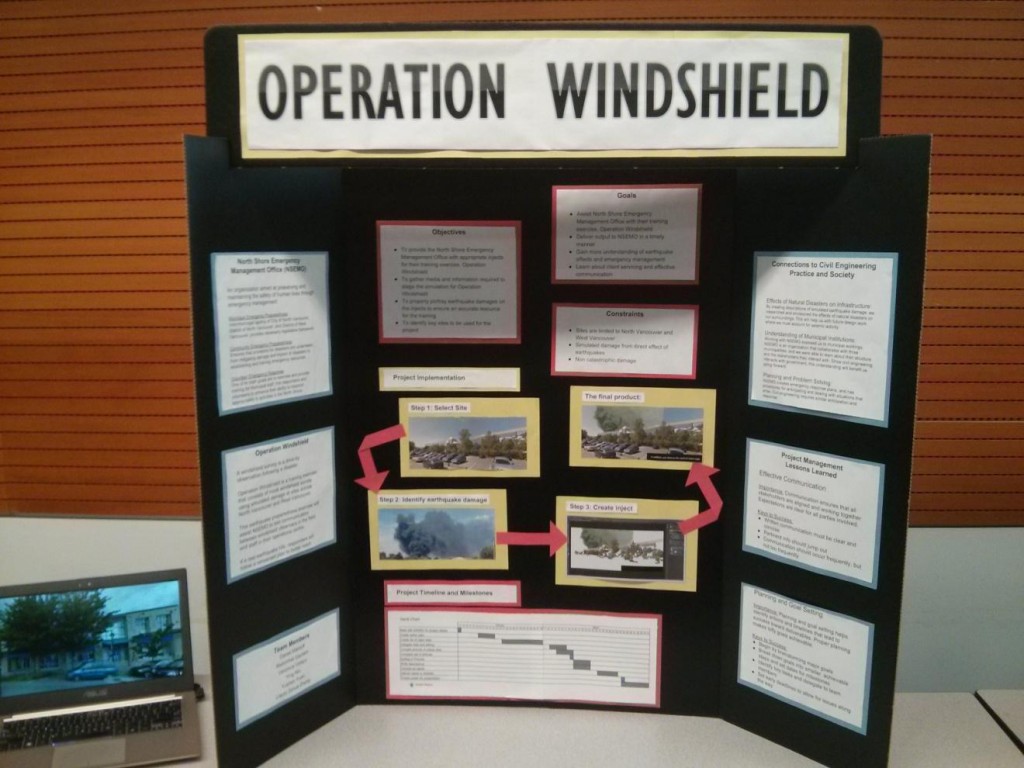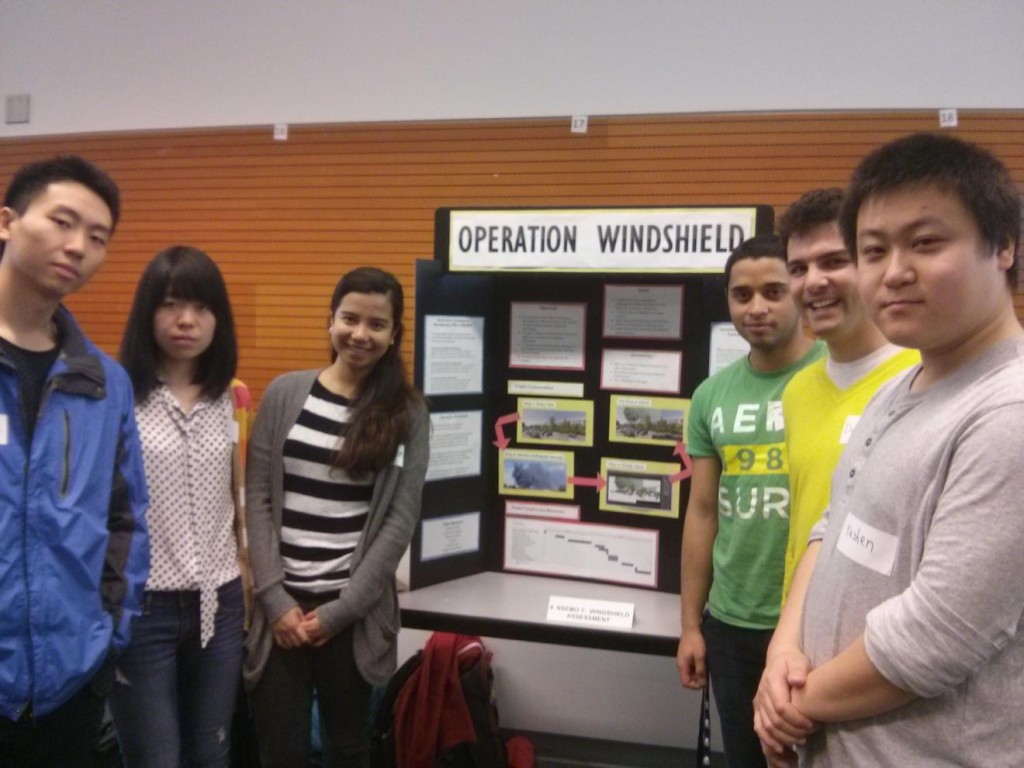The project is now complete and we can reflect on what we achieved over the past months. Working with our client, the North Shore Emergency Management Office (NSEMO), we created and delivered photographic and written descriptions of simulated earthquake damage at sites in North Vancouver and West Vancouver. They will use the injects we created during Operation Windshield, an earthquake training exercise taking place in June 2014. Responders will drive to sites on the North Shore, open an envelope with our simulated damage descriptions inside and report the damage back to NSEMO’s operations centre. This training operation will ensure earthquake preparedness and will test lines of communication between those in the field and the operations centre.
Poster Presentation
Following completion of the project, we created a poster presentation to share what we did with our classmates. It included relevant background information on the project and NSEMO, a description of our process and implementation plan, and some reflections on the impact of our work and the project’s relevance to civil engineering practice. We enjoyed sharing our work with our colleagues and also seeing their posters and learning about what they contributed to other organizations.
Effect on the Community
Operation Windshield will benefit citizens of North and West Vancouver by increasing preparedness should an earthquake occur. This training exercise allow NSEMO to test their response plans and work to keep their community safe in the face of a disaster.
By creating descriptions and photos of simulated earthquake damage, we handled a labour-intensive preparatory aspect of this operation, allowing NSEMO to focus on their day-to-day operations in the meantime. The injects we created are a central tool for the training operation and our work will allow the exercise to take place.
Also, our research into earthquake damage will help North and West Vancouver to become aware of possible earthquake impact on their infrastructure. The photo injects we created present potential damage to specific sites in a visual manner, assisting emergency response planners to know what they encounter.
What We Have Learned
Over the course of the project, each group member gained valuable experience that they can carry forward into their careers. The most pertinent lessons came from understanding the project’s context within its served community and through acquisition of project management skills such as planning and implementation. Each team member has shared their thoughts.
“By completing the CBEL project, I learned important lessons in project management. The project ran extremely smoothly. We were able to deliver an excellent product to our client within the deadline. This was mainly due to our extensive planning and goal setting, where we broke down large tasks into achievable milestones and set early deadlines to allow for problem solving. These planning strategies will help us during our careers. Also, working with NSEMO provided us with exposure to the workings of government. This organization works with three municipalities, and meeting with them was insightful in learning about the stakeholders and relevant institutions. Understanding how cities work is important for civil engineers, and this first exposure will be useful to us going forward.”
—Daniel Maldoff
“I believe that working with my group on this CBEL project has been extremely beneficial. I have gained valuable experience in team work and what its like to be working on a real world project with others. The ability to get along with people of various personalities and work alongside them is extremely useful in the future as a civil engineer. Working with this group, I have learned how to manage heavy workloads and how to delicate different tasks to different members depending on their skill set. Each member of the group is able to contribute in different ways, and its important to figure out each member’s interests. In addition to this, we’ve learned how to efficiently manage time and get tasks done in a timely manner. Experience in all these fields is very useful since as civil engineers, we will be required to work with colleagues on a daily basis.”
—Nishchhal Gautam
“In any civil engineering project, proper project management is needed to ensure project success. The team learned crucial project management skills such as communication skills while completing the CBEL project. Communication skills is important in dealing with colleagues, clients, and other stakeholders so that project planning and execution will run smoothly and efficiently. Knowing how to communicate effectively and professionally is a skill that can be used not only in civil Engineering but in other industries and fields as well.”
—Veronica Velayo
“Through the Operation Windshield project, we practiced and improved mostly on team working and client communication skills. Active collaboration and interaction among team members was the key of the successful completion of the tasks. At the same time, communicating with the client clearly and effectively, constantly informing the client on the project progresses to make the client stay on track is usually helpful in meeting the client’s requirements and expectations. These are the basic skills a professional engineer should have and therefore the CBEL experience is positive for our future engineering practices.”
—Ying Niu
“By doing this project, I learned how to communicate with a real client and a real organization properly. The ability to exchange information with the other party is extremely important and beneficial. It can help me understand my client’s and colleague’s requirement better and finish the task as they want in a professional manner in future. Also, working in a group for the whole term really improved my team work ability. I now have a clearer concept about how to work in a team environment efficiently. Last but not least, by working for a real organization, I gained more knowledge and experience about how the civil engineering industry works.”
—Zehua Zhang
We are thrilled to have delivered an excellent product to NSEMO that is of benefit to its community and appreciate the project management skills and experience we have acquired. With the project complete, we are proud of our work and will carry this experience forward into our careers.


